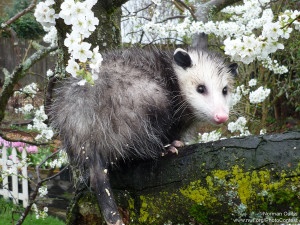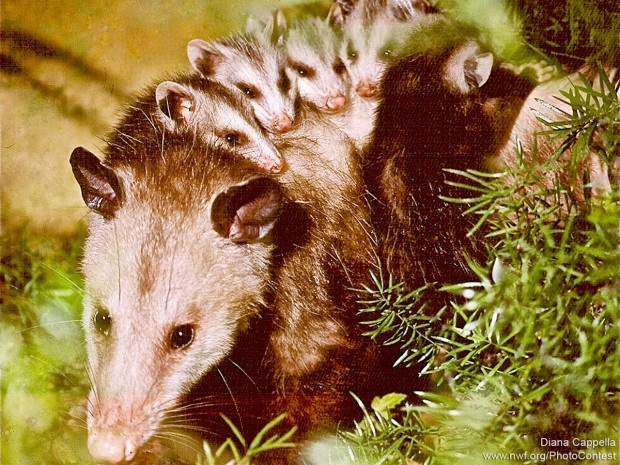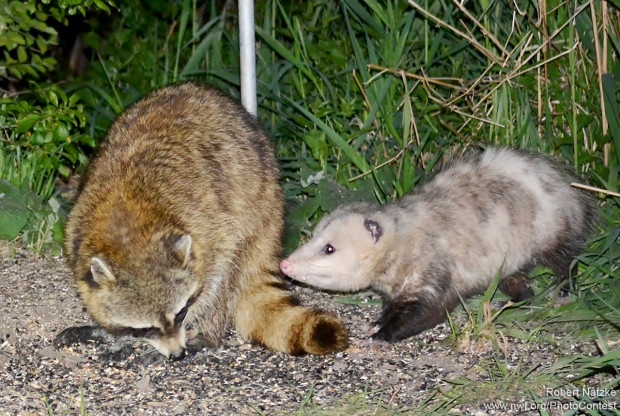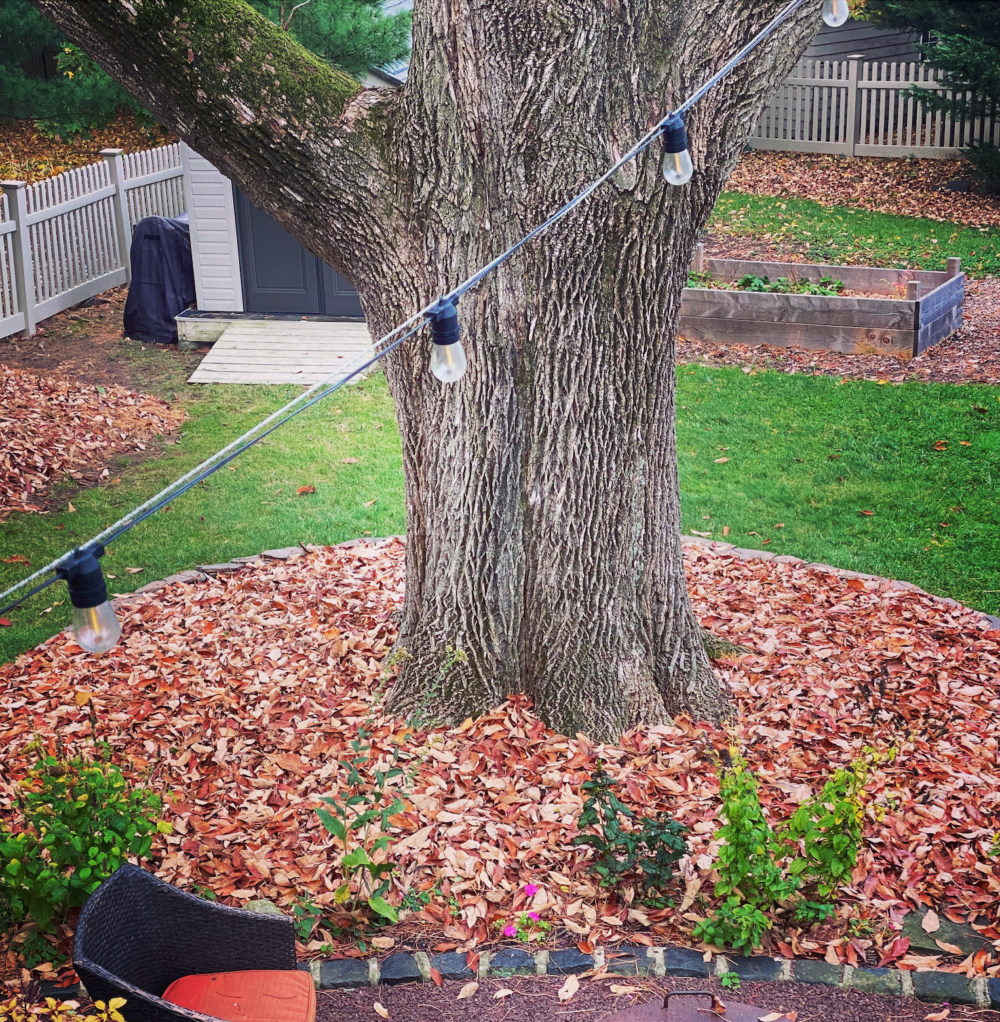We have much more to do and your continued support is needed now more than ever.
Opossums and Gardening: A Few Things to Know

The opossum is one of the most frequently encountered U.S. wildlife species, showing up in woods and swamps, plains and marshes, cities and suburbs—and in backyard gardens, where it may play some important roles in controlling garden pests and even in limiting ticks.
It may look like a big, grayish-white rat, but truly the opossum is something special in the realm of North American wildlife. Its ancestors can be traced back roughly 65 million years, to physically similar animals that lived in the shadow of the dinosaurs and probably fed on dinosaur eggs. Any creature that lasts that long with the same body plan is doing something right. The only U.S. marsupial, the Virginia opossum—named after the region in which Europeans first encountered it—has endured because its behavior is highly flexible—it can eat almost anything and find shelter almost anywhere.
Here are a dozen highlights you may enjoy about this neighborly species, which shares with you the habitat it has lived in for hundreds of thousands of years:
- The Virginia opossum is about the size of a house cat (making it the largest of the Western Hemisphere’s 100-plus opossum species), with a naked, scaly tail; a long, pointed face; a pink or reddish button nose; and leathery, rounded ears like the leaves of a geranium.
- The opossum gives birth to bumble-bee-sized young in an almost embryonic stage of development but capable of crawling along the mother’s body to her pouch, a characteristic of all marsupials, from kangaroos to wombats. In the pouch, each young latches on to one of thirteen teats, remaining attached until ready to leave the pouch in about 11 weeks. As they mature, the young continue clinging to the mother’s hair and using her for transportation.

Female opossums will carry maturing young on their backs, as this mother is doing in Palm Beach Gardens, Florida. A mother’s load can be burdensome, given that a female can produce as many as 13 young at a time. Photo by Diana Cappella. - The opossum’s tail is prehensile, meaning it can wrap around and hold on to tree limbs, an aid in climbing. Young ones may hang by their tails, but adults are too heavy to do so.
- Virginia opossums show more variation in size than almost any other mammal. Adult males can measure about 1 to 3 feet long from the tip of the nose to the base of the tail and weigh 1.5 to 14 pounds. Ranging from southern Canada down into Costa Rica, they reach their largest size in the north.
- The name “opossum” is derived from an Algonquian word meaning “white animal.”
- Opossums are unusually resistant to snake venom. The bites of rattlesnakes and similar vipers usually aren’t fatal or even harmful to them.
- Unlike skunks and raccoons, opossums are not prone to rabies infections.
- Virginia opossums eat almost anything, from bird eggs to acorns, from slugs and frogs to fruit.
- As is typical for marsupials, opossums possess a rudimentary brain, about a fifth the size of a raccoon’s.
- Adult opossums are solitary and nocturnal—active at night—and generally live in burrows and cavities that they find ready-made rather than create themselves. They seek shelter underground, in trees or anywhere in between.
- When frightened or harmed, opossums go into a sort of torpor, lying still as death—the famous act of “playing ’possum.” But they are not exactly playing. They have no control over this response, which could be said to paralyze them with fear. Their lips draw back, revealing their teeth in a sardonic grin, and anal glands spew a foul-smelling fluid that deters potential predators. If left unharmed, a catatonic opossum will recover in roughly one to four hours. Younger opossums are less likely than mature individuals to play ’possum, but even older animals can’t be relied on always to collapse in a confrontation—they may growl, bite or, most typically, flee—at a top speed of perhaps 7 miles per hour. Almost any predator can outrun them, which may be why playing ’possum evolved as a defense.
- Opossum meat was historically a favored food in the Deep South, and ’possum grease was used in traditional medicine as a chest rub for respiratory ailments.
Opossums and Gardening

As omnivores, opossums will police your garden, feeding on insect pests, garden slugs, rodents, toads, snakes and even dead animals that might otherwise rot in place. They may pose an occasional threat to garden fruits and vegetables, but they tend to prefer plant matter that is starting to rot, so chances are they will help clean up, rather than clean out, your garden. If a ’possum does take up residence in your yard and dine on plants you consider off limits, you can use the following measures to stop it:
- If an opossum dens under your house or other structures, block its entryway with wadded newspaper during the day, when the animal is sure to be inside. After sundown, check to see if it has pushed out the paper—if so, you know it is no longer inside, and you can cover the entrance with wire mesh or some other material that will block the animal. Another way to be sure the ’possum is away is to put a layer of flour along the ground outside the entrance, then look for footprints after dark.
- You can try several sprays that discourage opossums. Squirt some liquid soap into a quart of water and then add a cup of molasses or hot sauces and chopped hot peppers or mustard, and spray plants with one of these concoctions. The taste will drive away opossums. The hot stuff also will discourage squirrels.
- Some sources recommend putting moth balls into cavities and around plants from which you want to discourage opossums, but moth balls are toxic, so you should avoid this approach.
- Another suggestion is to put towels into a coffee can with holes punched through it. Saturate the towels with ammonia, put on the plastic lid and situate the can in a place from which you wish to banish opossums. Of course, given the aroma of ammonia, you might find yourself avoiding the area, too.
But in all, opossums are creatures with which you can probably live and let live—they come out after dark, so you may never see them, and they’ll run from you if you do; they eat pests; and they don’t carry rabies. They may even help reduce ticks in your yard. Recent research by the Cary Institute of Ecosystem Studies found that opossums eat about 90 percent of the ticks that attack them, accounting for perhaps 5,000 ticks per ’possum per tick season. “They’re net destroyers of ticks,” says Richard Ostfeld, a forest ecologist with the institute.





















